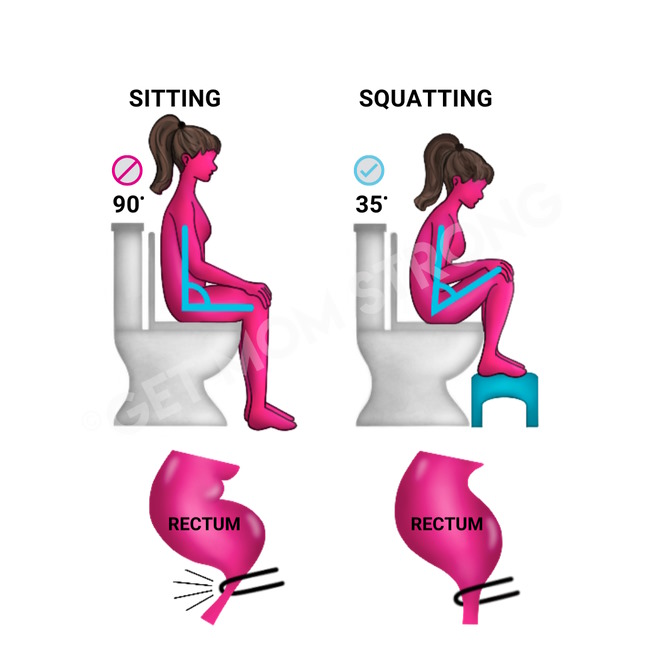Pelvic floor dysfunction may be playing a part in your constipation struggles. Here are some pelvic floor exercises for constipation that can help move things along.
Is Your Pelvic Floor to Blame for Your Constipation?
Often, the only remedy given for constipation is to drink more water and eat more fiber. These tips are LEGIT, and they also help with bloating, which can be a side effect of diastasis recti.
However, consider that the pelvic floor is a bowl of muscles that holds our bladder, rectum (the poop shoot), and uterus where they belong.
When you sit on the toilet, the pelvic floor muscles are meant to relax. This lets us release our bowels and urine. But sometimes, these muscles are chronically tight and have trouble properly letting go. Signs this may be the case:
- Trouble releasing bowel movement.
- A sensation of an “incomplete” bowel movement.
- Thin or “pencil” like stool.
- Difficulty starting your stream of urine.
- Leaking urine or stool.
It is normal to poop anywhere from three times a week to three times a day. It varies greatly between each individual, but if you are feeling discomfort or going to the bathroom less than what is normal for you, then let’s talk about how to fix it.
Pelvic Floor Therapy For Constipation
First and foremost, go see a pelvic floor physical therapist. A pelvic floor physical therapist will assess your pelvic floor function and coordination.
Buy A Poop Stool
Buy a Squatty Potty stool. Simply placing a stool under your feet helps to shift the position of your rectum, allowing for better voiding.
If you experience incomplete voiding (i.e. you don’t feel like you’ve gotten everything out), a simple shift in body mechanics can make a big difference.
Think of it like a slide at the park. When you are completely upright, you are asking your poop to make it down the curvy slide.
When you forward lean and prop the feet up, you are sending it down the straight (much faster) slide.

Hydration & Fiber Help
Drink lots of water. Most of us are mildly dehydrated. When your body is properly hydrated, less water will be withdrawn from the colon.
This will keep your stool soft and easy to pass. Add some lemon juice as a bonus. This helps with flavor, but the citrus can also help stimulate bowels.
Eat fiber. Fruits, veggies, whole grains, legumes. You know the deal.
Here is a link to my Poop Balls recipe. When I need to get things moving, these tasty balls are perfect.
Physical Therapy Exercise For Constipation
This simple abdominal massage can relieve constipation by getting things flowing.
Try the I Love U massage. Add a little lotion to your fingertips.
“I”: Start on the lower right side of your abdomen. Press down and then scoop your hands up toward ribs.
“L”: Next go to the left.
“U”: Finally, come back down, ending at the lower left part of your tummy.
Obviously, this one isn’t good to do while pregnant.
Pelvic Floor Exercises and Deep Breathing Daily
Pelvic floor tightness is a real thing. Many women hold tension and stress in their pelvic floor. These are the best pelvic floor exercises for constipation!
Try doing these deep breathing pelvic floor releases for a couple minutes in the morning and again in the evening. And when you are pooping, don’t bear down.
Simply breathe deeply down into your body, and then gently exhale like you are blowing out birthday candles. This will make your pelvic floor so much happier, and hopefully get things moving along.
One last important note. Pay attention to the urge to poop. On the flip side of that, make sure that you aren’t sitting on the toilet too long waiting for things to happen. Both of these habits mess with our pelvic floor coordination to get the job done.
I sure hope this brings you a little relief.
I’m going to say it one more time. If you are chronically constipated—go see a pelvic floor PT!
Strong Like A Mother (SLAM) is a total body fitness program that loves your core and pelvic floor. In addition to kick-butt workouts that help improve diastasis recti, prolapse, incontinence, back pain, and more–you also get weekly rest day tips to help educate and empower you.
